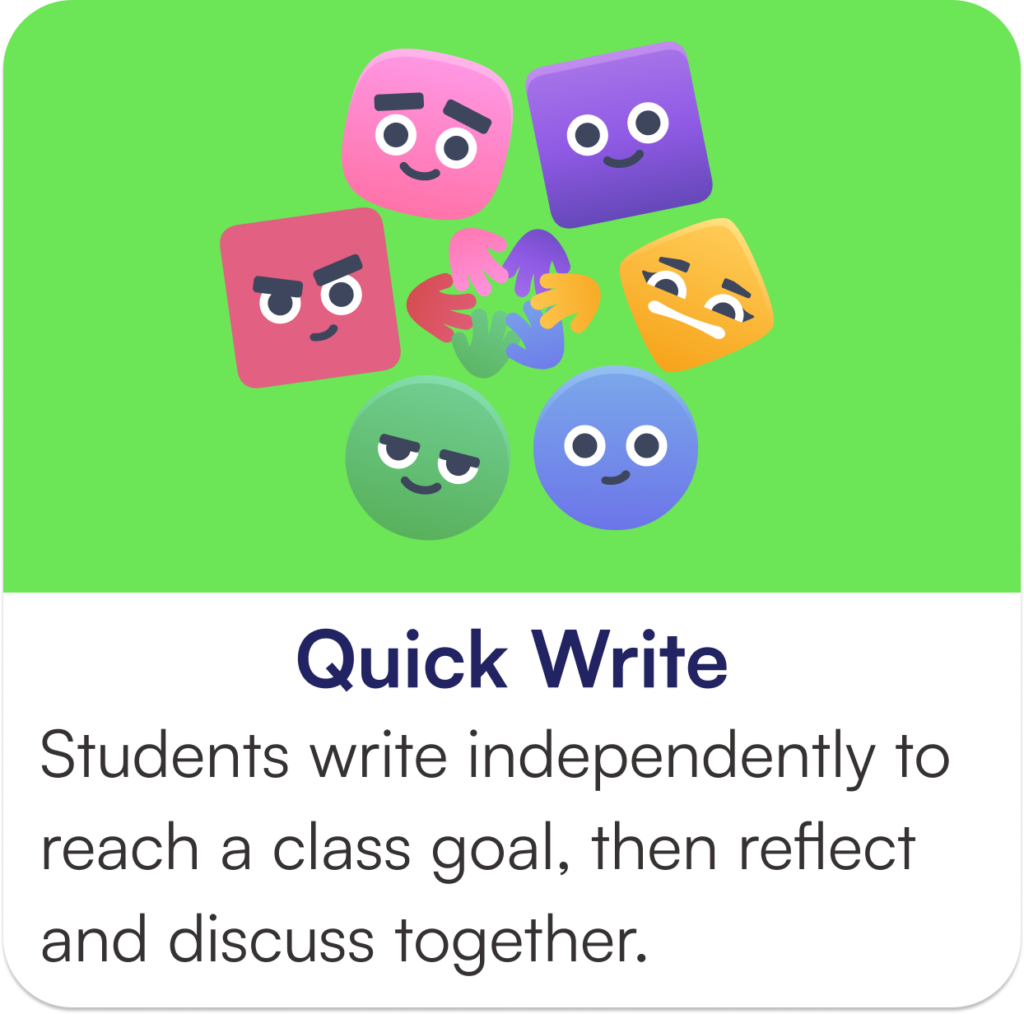What is Quick Write?
Quick Write is Short Answer’s newest activity (use the clickable walkthrough below to preview). Students submit a response, then receive a proficiency score and AI feedback for each success criteria. The class earns points based on proficiency scores with a cooperative goal of hitting a target class score. Students can then pair up and discuss the results together. Quick Write is Short Answer’s first activity to feature student-facing AI. In this post, we want to explain more about how and why we’re using AI.
NOTE: After April 14th, 2025, Quick Write will only be available to teachers with a Short Answer Premium account. If you use the free version of Short Answer but would like to access Quick Write for the rest of the 2024-2025 school year, see our special promotion here.
How does Quick Write use AI?
AI is used provide one of three proficiency scores and feeback to student writing based on the success criteria assigned by the teacher:
- Advanced: Success criterion is fully demonstrated with strong execution
- Intermediate: Success criterion is partially demonstrated but has gaps
- Beginner: Success criterion is absent, misunderstood, or incorrectly executed
Is it safe to use AI with my students in Quick Write
Yes. We’ve taken several steps to ensure students are safe, including:
Students cannot interact with AI (i.e. go back and forth via a chatbot interface). AI will only provide feedback on their writing based on teacher-defined criteria.
Students sign in using a one-time join code, so no personally identifiable information (PII) is required (e.g. full names, email, demographics, etc.)
Writing is anonymized when passed to AI
Amazon Bedrock is used for AI services, creating a safety layer to ensure no data is shared directly with AI model providers and enabling guardrails to help prevent unintentional sharing of PII, hallucination, etc.
Short Answer uses the best available Large Language AI models
Short Answer does not fine-tune models based on student data
Students are prompted to think critically about AI outputs throughout the activity, including messaging that includes:
“AI is a tool, not a replacement for your own thinking”
“AIs can make things up. Verify info with your teacher, textbook, or reliable online sources”
“AI gives suggestions, but you make the final choices”
“Your teacher is your best resource for writing guidance”
Students can flag feedback for review by the teacher, who can update scores and adjust AI feedback accordingly
Is there research to support Quick Write's approach?
Yes.
A 2024 study by researchers at UC Irvine and Arizona State investigated AI’s ability to score student writing. 1,786 teacher-scored, 6th-12th grade History, ELA, and persuasive essays were used. Researchers used AI to score the same pieces of writing and found only a small difference between AI and teacher scores. When asked to score the same piece of writing repeatedly, AI would also score it consistently. These findings aligned with previous research.
To quote the authors, AI “is sufficiently reliable and valid in providing a sense of the student’s achievement level and could provide an impetus for revision.” This finding, combined with other research showing the value of formative AI-feedback on student writing, gave us the confidence to build Quick Write.
Quick Write also further supports our theory of change by actualizing Dr. Paul Black and Dr. Dylan Wiliam’s (note: Dr. Wiliam advises Short Answer) framework for effective formative assessment. Feedback is organized by success criterion to clarify learning intentions, results are shared publicly to help engineer effective classroom discussions, and individual feedback is provided that moves learning forward.
We also structured Quick Write to align with Dr. Wiliam’s guidance on effective cooperative learning. To quote Dr. Wiliam: “Effective cooperative learning requires the presence of two elements: First, there must be group goals, so that students are working as a group, not merely in a group.” We achieve this in Quick Write by having the class work together to reach a target score goal. “Second, there must be individual accountability, so that individual students cannot ride the coattails of others’ work.” We achieve this by scoring student responses individually in Quick Write. For more on how to structure cooperative learning tasks, see p.156-160 of Dr. Wiliam’s Embedded Formative Assessment.
Public BETA
After April 14th, Quick Write will only be available to teachers with Short Answer Premium accounts. We’ve launched it today as a freely available, public BETA as we work to improve it. If you use the free version of Short Answer but would like to maintain access to Quick Write for the rest of the 2024-2025 school year, please see our special promotion here.
If you’re interested in finding out more about Short Answer, the writing-focused workshops we offer, or just want to chat, please reach out below!








